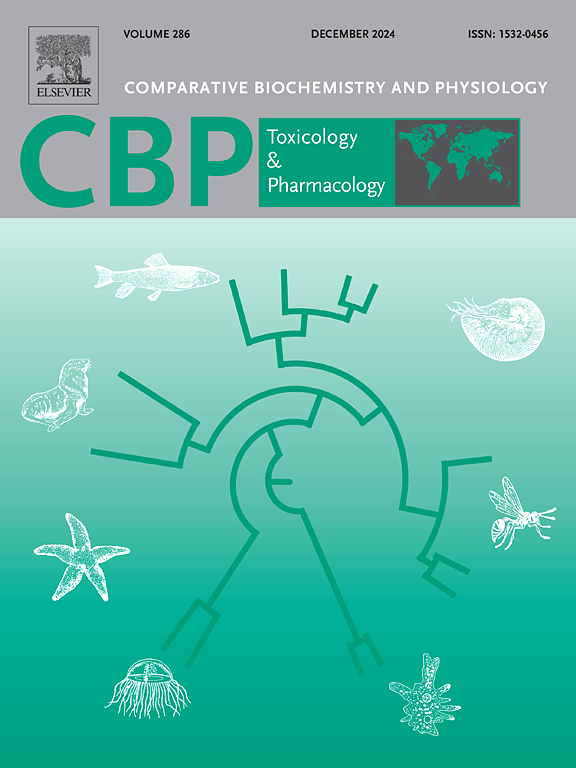Identification of allelochemicals from three submerged plants and the inhibitory effects of organic acids on cyanobacteria (Cylindrospermopsis raciborskii)
IF 4.3
3区 环境科学与生态学
Q2 BIOCHEMISTRY & MOLECULAR BIOLOGY
Comparative Biochemistry and Physiology C-toxicology & Pharmacology
Pub Date : 2025-06-15
DOI:10.1016/j.cbpc.2025.110251
引用次数: 0
Abstract
Cyanobacteria (C. raciborskii), as a type of harmful algal bloom cyanobacteria, has strong invasiveness and has received widespread attention in eutrophic waters. Using allelopathic organic acids from submerged plants offers a promising strategy for controlling its blooms. This study investigated inhibitory effects of four plant-derived organic acids, including ellagic acid, gallic acid, caffeic acid, and p-hydroxybenzoic acid, on C. raciborskii through growth parameters, chlorophyll-a content, photosynthetic systems, and antioxidant responses. The results indicated that these organic acids significantly altered the concentrations of photosynthetic pigments, alkaline phosphatase (ALP) activity, and antioxidant enzyme activities of C. raciborskii. Different concentrations of organic acids had a significant influence on the intracellular photosynthetic pigment levels of C. raciborskii. These results revealed the reduction of chlorophyll-a was dose-dependent and time-dependent under the action of ellagic acid and gallic acid. All tested acids markedly elevated the alkaline phosphatase activity (248–398 % of the control group). Organic acids also significantly affected the activities of superoxide dismutase, catalase, and glutathione peroxidase, while increasing the level of malondialdehyde, indicating enhanced cellular oxidative stress. These findings suggest that organic acids inhibit photosynthetic pigment synthesis, phosphorus uptake, and antioxidative defenses, ultimately suppressing the growth of C. raciborskii.

3种沉水植物化感物质的鉴定及有机酸对蓝藻的抑制作用
蓝细菌(C. raciborskii)作为一种有害藻华蓝藻,在富营养化水体中具有很强的侵袭性,受到了广泛的关注。利用沉水植物中的化感有机酸为控制其开花提供了一种很有前途的策略。本研究考察了鞣花酸、没食子酸、咖啡酸和对羟基苯甲酸等四种植物源有机酸通过生长参数、叶绿素-a含量、光合系统和抗氧化反应等对raciborskii的抑制作用。结果表明,有机酸显著改变了柠条光合色素浓度、碱性磷酸酶(ALP)活性和抗氧化酶活性。不同浓度的有机酸对茜草胞内光合色素水平有显著影响。结果表明,在鞣花酸和没食子酸的作用下,叶绿素-a的还原具有剂量依赖性和时间依赖性。所有被测酸均显著提高碱性磷酸酶活性(为对照组的248 - 398%)。有机酸还显著影响了超氧化物歧化酶、过氧化氢酶和谷胱甘肽过氧化物酶的活性,同时增加了丙二醛的水平,表明细胞氧化应激增强。这些结果表明,有机酸抑制了光合色素合成、磷吸收和抗氧化防御,最终抑制了黄颡鱼的生长。
本文章由计算机程序翻译,如有差异,请以英文原文为准。
求助全文
约1分钟内获得全文
求助全文
来源期刊
CiteScore
7.50
自引率
5.10%
发文量
206
审稿时长
30 days
期刊介绍:
Part C: Toxicology and Pharmacology. This journal is concerned with chemical and drug action at different levels of organization, biotransformation of xenobiotics, mechanisms of toxicity, including reactive oxygen species and carcinogenesis, endocrine disruptors, natural products chemistry, and signal transduction with a molecular approach to these fields.

 求助内容:
求助内容: 应助结果提醒方式:
应助结果提醒方式:


